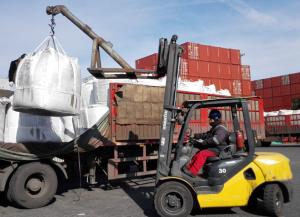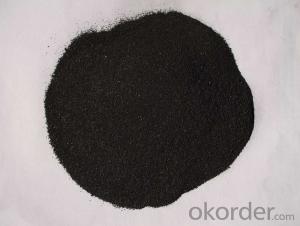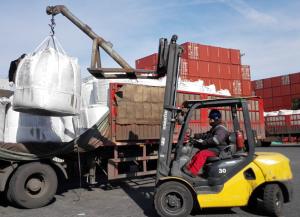Calcined Petroleum Coke FC98% from CNBM China
- Loading Port:
- Tianjin
- Payment Terms:
- TT or LC
- Min Order Qty:
- 20 m.t.
- Supply Capability:
- 1500 m.t./month
OKorder Service Pledge
OKorder Financial Service
You Might Also Like
Quick Details
Place of Origin: China (Mainland)
Application: carben additives
Dimensions: fix carben morethan98%,sulphur less5%
Chemical Composition: nature graphite powder
attribute: briquette grade
shape: <SPAN style="BORDER-BOTTOM: 0px; BORDER-LEFT: 0px; PADDING-BOTTOM: 0px; MARGIN: 0px; PADDING-LEFT: 0px; PADDING-RIGHT: 0px; FONT-FAMILY: inherit; WORD-WRAP: break-word; VERTICAL-ALIGN: baseline; BORDER-TOP: 0px; BORDER-RIGHT: 0px; PADDING-TOP: 0px" class=attr-value title=block/powder>block/powder
classify: carbon additives/petroleum coke
Packaging & Delivery
| Packaging Details: | 50kg/bag,25kg/bag or as customer requirement |
|---|---|
| Delivery Detail: | 20DAYS after payment |
Specifications
Calcined Petroleum Coke FC98% from CNBM China
Petroleum coke products can be divided into needle coke, sponge coke, projectile coke and coke breeze four kinds.
Calcined Petroleum Coke
F.C.: 98.5%MIN
ASH: 0.8% MAX
V.M.: 0.7%MAX
S:0.5%MAX
Moisture: 0.5%MAX
Structure
Calcined Petroleum Coke FC98% from CNBM China
Shape: granule
- Dimensions: 0-1mm, 1-5mm, 1-6mm, 2-8mm, etc
- Product Type: Carbon Additive
- C Content (%): 98-99.5% MIN
- Working Temperature: -
- S Content (%): 0.5%-0.7%MAX
- Ash Content (%): 0.7%MAX
- Volatile:0.8%MAX
- Moisture: 0.5% MAX
- ADVANTAGE: low ash & sulfur
- COLOR: Black
Feature
Calcined Petroleum Coke FC98% from CNBM China
Physics and chemistry performance:
Unit | Index | |||||
No.1 | No.2 | No.3 |
| |||
Density | g/cm3 | 2.04 | 2.00 | 2.00 | ||
sulphur content | %≤ | 0.5 | 1.0 | 2.5 | ||
volatility | %≤ | 0.5 | 0.5 | 0.5 | ||
ash content | %≤ | 0.5 | 0.5 | 0.5 | ||
moisture | %≤ | 0.3 | 0.5 | 0.5 | ||
charcoal | %≤ | 98.5 | 98.0 | 98.0 | ||
Image
Calcined Petroleum Coke FC98% from CNBM China
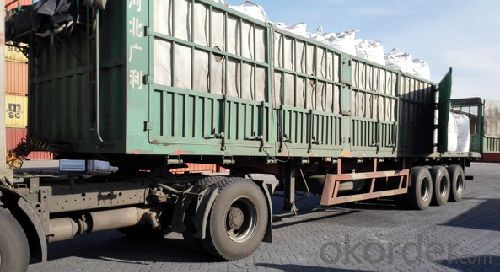
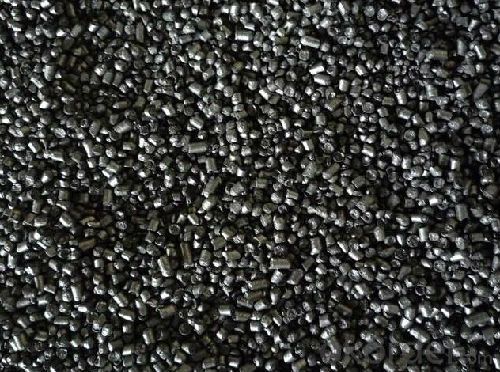
FAQ:
Calcined Petroleum Coke FC98% from CNBM China
How to classify calcined petroleum coke?
1) According to difference of sulfur content, can be divided into high sulfur coke (sulfur content more than 4%), sulphur in coke sulfur content (2% 4%) and low sulfur coke (sulfur content below 2%).
2) Petroleum coke products can be divided into needle coke, sponge coke, projectile coke and coke breeze four kinds:
3) Needle coke, has obvious needle-like structure and fiber texture, mainly used for steel-making in high power and ultra-high power graphite electrode. As a result of needle coke in sulfur content, ash content, volatile matter and true density and so on have strict quality requirements, so the production process of needle coke and raw materials have special requirements.
4) The sponge coke, high chemical reactivity, low content of impurities, mainly used in the aluminum industry and carbon industry.
5) Focal or spherical coke: the projectile shape is round, diameter 0.6-30 mm, usually from the production of high sulphur, high asphaltic residual oil, can only be used as industrial fuel power generation, cement etc.
6) Coke breeze: fluidized coking process, the fine particles (0.1- 0.4 mm) in diameter, high volatile, high expansion coefficient, cannot be directly used for electrode preparation and carbon industry.
Advantage:
Calcined Petroleum Coke FC98% from CNBM China
1. High quality and competitive price.
2. Timely delivery.
3. If any item you like. Please contact us.
Your sincere inquiries are typically answered within 24 hours.
- Q:Carbon 60 related information
- The 60 is the solid carbon black, graphite and diamond. In addition, in recent years, scientists have discovered that some exist in new form of elemental carbon, which is more important in 1985 found C60. C60 is a molecule made up of 60 carbon atoms, similar to football. At present, people have made great progress in the research of C60, and the application of C60 in superconductor, material science and other fields is deepening. In our country, great achievements have been made in this field. For example, the metal doped C60 superconductor has been successfully developed in collaboration with the Physics Institute of Peking University and the Chinese Academy of sciences. It can be said that the discovery of C60 is of great importance to the study of carbon chemistry and even the whole field of chemistry.
- Q:How is carbon used in the production of solar cells?
- Solar cells do not directly utilize carbon in their production. Instead, semiconductor materials like silicon or cadmium telluride are typically used to create solar cells. Nevertheless, carbon-based materials can greatly enhance the efficiency and effectiveness of solar cells. Carbon, in the form of carbon nanotubes, can be employed as a see-through electrode within solar cells. Carbon nanotubes possess exceptional electrical conductivity and optical transparency, making them an ideal substitute for conventional transparent conductive materials such as indium tin oxide. Moreover, carbon-based materials can serve as a protective coating or encapsulation layer, safeguarding solar cells against moisture, corrosion, and mechanical strain. Carbon-based materials also have the potential to revolutionize solar cell technology by contributing to the development of cutting-edge solar cell types such as organic solar cells or perovskite solar cells. These advanced solar cells utilize carbon-based compounds in their active layers. In summary, although carbon is not directly involved in the production of solar cells, it plays a critical role in enhancing their performance and enabling the progress of more sophisticated solar cell technologies.
- Q:What are the consequences of increased carbon emissions on global food security?
- Increased carbon emissions have significant consequences on global food security. One of the most immediate impacts is the alteration of weather patterns and increased frequency of extreme weather events such as droughts, floods, and heatwaves. These events can lead to crop failures, reduced agricultural productivity, and loss of livestock, ultimately resulting in food shortages and price volatility. Carbon emissions also contribute to climate change, leading to long-term shifts in temperature and precipitation patterns. Higher temperatures can accelerate the growth and reproduction rates of pests and diseases, which can devastate crops and livestock. Additionally, changes in rainfall patterns can disrupt the timing and quantity of water available for irrigation, further reducing agricultural productivity. Furthermore, carbon emissions contribute to the acidification of oceans, which negatively affects marine ecosystems and the livelihoods of communities dependent on fishing and aquaculture. This can lead to a decline in fish stocks, threatening the availability of a vital source of protein and nutrition for millions of people. Another consequence of increased carbon emissions is the loss of biodiversity. Climate change can disrupt ecosystems, leading to the extinction or migration of plant and animal species. This loss of biodiversity reduces the resilience and adaptability of agricultural systems, making them more vulnerable to pests, diseases, and environmental stresses. Ultimately, the consequences of increased carbon emissions on global food security are far-reaching and complex. They include decreased agricultural productivity, increased food prices, food shortages, and reduced access to nutritious food. Addressing carbon emissions and mitigating climate change is crucial to ensure a sustainable and secure global food system for future generations.
- Q:How does carbon contribute to the strength of alloys?
- Carbon contributes to the strength of alloys by forming interstitial solid solutions with metals, which increases the hardness and strength of the material. The carbon atoms occupy the spaces between the metal atoms, creating lattice distortions and enhancing the overall strength of the alloy. Additionally, carbon can also form compounds with metals, such as carbides, which further improve the hardness and wear resistance of alloys.
- Q:What does carbon burning mean?
- Carbon burning means that the source of fire is carbon fire."Carbon coffee" means that the source of roasted coffee is carbon, fire, and sometimes special wood as fuel, because the roasted beans with carbon fire will have wood flavor, not carbon burning flavor.The charcoal pasta has nothing to do with carbon fire, but there is another name - egg Bacon noodles. Spaghetti comes in many ways, mainly because sauces play a decisive role, and carbon burning pasta is named for its sauce color.
- Q:What is the effect of carbon equivalent on welding?
- The carbon equivalent of less than 0.4%, good weldability; in 0.4~0.6%, poor weldability, welding preheating and other measures to prevent cracks; more than 0.6 words, when welding needs higher temperature and strict technical measures! PS: carbon equivalent =C+Mn/6+ (Ni+Cu) /15+ (Cr+Mo+V) /5, Q235 carbon content in 0.14%~0.22% between, widely used by the company seems to be Q235B, carbon content between 0.12~0.20%
- Q:Often see the so-called 30T, 46T, 60T carbon fiber, 60T carbon fiber, equivalent to T hundreds of carbon fibers, is T800, or T1000? I'm not very good at parameter conversion. Is there a parameter list? How do I correspond to the T300T700T800 performance parameter table?
- One, 60T carbon fiber and T hundreds of carbon fiber does not have any corresponding, 60T belongs to M series (high modulus carbon fiber). Only 30T corresponds to T800.
- Q:How is carbon used in the production of fuel cells?
- Carbon is used in the production of fuel cells in several ways. One of the main uses of carbon in fuel cells is in the construction of the electrodes. Fuel cells consist of an anode and a cathode, and carbon-based materials such as graphite or carbon paper are commonly used to make these electrodes. These carbon-based materials provide a conductive surface for the electrochemical reactions that occur within the fuel cell. Additionally, carbon is used as a catalyst in fuel cells. Catalysts are substances that speed up chemical reactions without being consumed in the process. In fuel cells, carbon-based catalysts such as platinum or palladium are commonly used to facilitate the reactions that produce electricity. These catalysts allow for more efficient conversion of fuel into electrical energy. Furthermore, carbon is used in the form of carbon nanotubes in the production of fuel cells. Carbon nanotubes possess unique properties such as high surface area and excellent electrical conductivity, which make them ideal for enhancing the performance of fuel cells. They can be used to improve the efficiency of fuel cell reactions by providing a larger surface area for the reactions to take place on. Overall, carbon plays a crucial role in the production of fuel cells by providing the necessary materials for the construction of electrodes, serving as catalysts for the electrochemical reactions, and enhancing the performance of fuel cells through the use of carbon nanotubes.
- Q:What is the concept of carbon equivalent? What is the relationship between carbon equivalent and weldability?
- In order to facilitate the expression of strength properties of these materials and welding performance simply to carbon equivalent to said through the statistics of test data.
- Q:How are carbon markets regulated?
- Carbon markets are regulated through a combination of international agreements, national legislation, and the oversight of regulatory bodies. These regulations aim to ensure the transparency, integrity, and effectiveness of carbon trading activities. They often include requirements for the accurate measurement and reporting of emissions, the establishment of reliable registries, the accreditation of market participants, and the enforcement of compliance mechanisms.
1. Manufacturer Overview |
|
|---|---|
| Location | |
| Year Established | |
| Annual Output Value | |
| Main Markets | |
| Company Certifications | |
2. Manufacturer Certificates |
|
|---|---|
| a) Certification Name | |
| Range | |
| Reference | |
| Validity Period | |
3. Manufacturer Capability |
|
|---|---|
| a)Trade Capacity | |
| Nearest Port | |
| Export Percentage | |
| No.of Employees in Trade Department | |
| Language Spoken: | |
| b)Factory Information | |
| Factory Size: | |
| No. of Production Lines | |
| Contract Manufacturing | |
| Product Price Range | |
Send your message to us
Calcined Petroleum Coke FC98% from CNBM China
- Loading Port:
- Tianjin
- Payment Terms:
- TT or LC
- Min Order Qty:
- 20 m.t.
- Supply Capability:
- 1500 m.t./month
OKorder Service Pledge
OKorder Financial Service
Similar products
New products
Hot products
Related keywords
